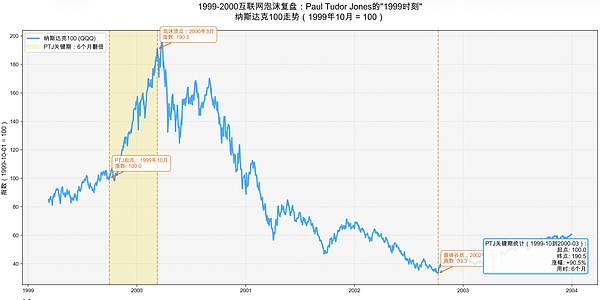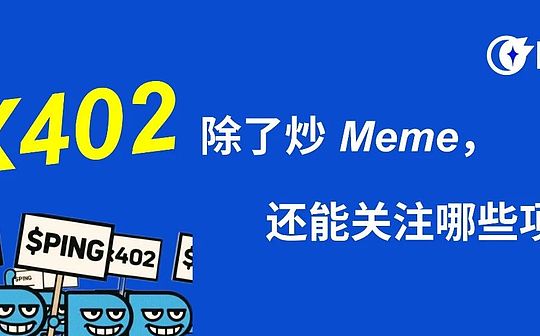
Core conclusion: This is not a bull market, this is the final sprint.
Paul Tudor Jones uses an extremely precise historical coordinate to define the current market: “Party like it’s 1999”
This is not nostalgia, this is not a metaphor.This is a trading order.

1. Why October 1999?precise anchor point given by history
The time slices chosen by Jones are extremely precise:October 1999 → March 2000.In 6 months, Nasdaq doubled.
This is not an ordinary bull market rally, but the “crazy acceleration phase” at the end of the bubble.
Howard Marks observed at the time:“The greatest price appreciation in a bull market always occurs in the last 12 months before the top.”
Historical data support:
•October 1, 1999: Nasdaq 2,746
•March 10, 2000: Nasdaq 5,048 (+84%)
•TheGlobe.com IPO (November 1998) soared 967% on the first day
•Priceline.com IPO (March 1999) rose 331% on the first day and was valued at $10 billion
This is what Jones calls “October of 99.”Not the starting point, but the starting line for final acceleration.
His ironclad logic:
•If you don’t participate, you miss out on all the essence
•To participate, you must run faster than everyone else
This is not strategy advice, this is bull market math.
2. But this time “brew” is more deadly: 1999 vs 2025 comparison
Jones uses a chemical term: “fiscal-monetary brew.”
This is not rhetoric, but a precise mechanistic description.
[1999: Interest rate hike + surplus]
Currency side:
•June 1999: Fed raises interest rates to 5.0%
•November 1999: Increased to 5.5%
•There were three more interest rate hikes in 2000 (finally 6.5%)
•Greenspan is applying the brakes in name, but “Greenspan Put” has taken shape
Financial side:
•1998-2000: Federal budget surplus
•1998 surplus of $69 billion
•Surplus of $237 billion in 2000 (highest ever)
Leverage tools:
•Mainly rely on margin trading (margin debt)
•October 1999: margin debt $228B
•2.5% of GDP
[2025: Interest Rate Cut + Deficit + New Leverage]
Currency side:
•Not a rate hike, but the eve of a rate cut
•3-4 interest rate cuts expected
•Real interest rates will go to zero or even become negative
•Jones’ original words: “Now it’s an interest rate cut, and 1999 was an interest rate increase.”
Financial side:
•6% structural fiscal deficit (vs 1999 surplus)
•Fiscal Year 2024 Deficit $1.8 Trillion
•National debt $36 trillion
•Buffett warns: ‘At some point it gets out of control’
Leverage tools:
•Not only margin, but also leveraged ETFs (3x leverage can be found everywhere)
•Option gamma squeeze mechanism (retail investors increase leverage by calling options)
•Meme stock communication mechanism (Reddit/X instant mobilization)
•Jones Watch: margin debt + leveraged ETFs > October 1999 levels
Conclusion:“This is a combination we haven’t seen since the 1950s after World War II.”
Broad money + loose finance = the perfect storm for a runaway bubble
And the result in the 1950s?Inflation explodes + stock market crashes.
3. Ignition mechanism: retail investors have entered the market, institutions are the last resort
Jones repeatedly emphasized one word: flow.
A bubble will not rise on its own, there must be an influx of buyers.There are three levels of buying:
[Ignition sequence in 1999]
The first stage: entry of retail investors
•The 401(k) revolution: 40 million people, $1.7 trillion
•Mutual funds: $170 billion in annual inflows 1995-1999
•Result: Total mutual fund assets of $7 trillion (more than the banking system)
Phase Two: CNBC Zoom
•Bill Bolster (CNBC President): “We are caught up in a Gulf War that will never end”
•24/7 bombing reports to maximize retail investors’ FOMO
•Result: Ratings skyrocketed, advertising fees skyrocketed, forming positive feedback
Stage Three: Institutional Surrender
•Long-short funds are forced to shift to long-only
•Value investors are scolded as “outdated”
•Julian Robertson (Tiger Fund) admitted defeat in March 2000: “We can’t use the old methods anymore” and closed the fund.
The final explosion: Greenspan cut interest rates three times from September to November 1998
•Bill Dudley (Chief Economist of Goldman Sachs): “The lifeguards are back and it’s time to go into the water.”
•This is perfect evidence of moral hazard
[2025: Same script, accelerated playback]
The first stage signal: retail investors have gone crazy
•Gold YTD +46-47% (non-traditional retail safe haven assets)
•Bitcoin YTD +50-60% (Digital Gold Narrative Success)
•Morgan Stanley meme basket +67-68% (purely retail driven)
Jones’ judgment:“Retail investors are already igniting the fire. What is missing now is the last rush of institutional funds.”
And why do institutions come in?
•TINA (there is no alternative)
•End of year mark pressure (cannot fall behind the benchmark)
•Career risk (knocked out like Julian Robertson in 1999)
This is not a rational choice, but a prisoner’s dilemma.Howard Marks calls it: “the perverse effect of competition.”
4. Circularity is disturbing: a repeat of RCA in 1999
When the host mentioned the circular deals of OpenAI-AMD and Nvidia, Jones only said one sentence:
“The circularity makes me nervous.”
What does this mean?
【The cycle of 1999】
RCA Lessons:
•1927-1929: RCA rose from $8 to $114
•Reason: Radio will “change the world”
•Result: Really changed the world
•But RCA fell to $2.50
•Still not recovered to 1/3 of 1929 high 25 years later
Lessons from the aviation industry:
•Buffett statistics: The aviation industry’s cumulative profits were zero by 1992
•“Changing the world ≠ investment profit”
Internet loop:
VC fundraising → Investing in Internet companies → The company burns money to buy traffic → IPO → VC exit → Re-raising funds → ...
•No external cash flow verification
•It all depends on the next round of taking over
[AI cycle in 2025]
OpenAI gets investment → Buy AMD/Nvidia chips → Chip manufacturers’ stock prices rise → Use stock warrants to reinvest in OpenAI → OpenAI’s valuation rises → Buy more chips → ...
This isself-referential valuation system(self-referential valuation).There is no terminal requirement verification.It all depends on the liquidity within the cycle.
Jones isn’t saying the game will be over anytime soon.He is reminding:This is the sign that the bubble is entering its final stage.
Warning from Howard Marks: “If it seems too good to be true, it probably is.”
5. Trading map: What to buy now?When to withdraw?
The configuration list given by Jones is extremely clear:
【Position Portfolio】
1. Gold (institutional hedging)
•Not an inflation hedge, but a confidence crisis hedge
•YTD +46% shows that the market is already pricing in “fiscal loss of control”
2. Bitcoin/crypto (digital gold + retail beta)
•+50-60% = Retail Sentiment Indicator
•Amplifier for foam acceleration section
3. Nasdaq/AI/Semiconductors (Narrative Center)
•Not because of fundamentals, but because this is the “rocket propulsion phase”
•Jones: “All the materials are here”
4. Meme stocks (the ultimate accelerator)
•MS meme basket +67%
•This is not value investing, this is momentum trading
Core logic:This is not an “inflation/deflation” trade, this is a “crisis of confidence + end of bubble” trade
【Time window】
Short term confirmation:
•Before the end of 2025 (organization mark node)
•“There will definitely be a market trend between now and the end of the year.”
Look at positioning in the mid-term:
•It’s not about narrative (how great AI is)
•Instead, look at positioning (leverage, retail investor participation, institutional positions)
•Jones: “Look at positioning, not story”
[Exit signal] (from 1999-2000 history)
Features of the March 2000 Top:
•Real interest rates are close to zero (Fed Funds 6%, CPI 3.5%)
•Margin debt accounts for 2.7% of GDP (record high)•Average first-day IPO gain > 100%
•Mary Meeker (Queen of the Internet) said: “This reminds me of Tulip Mania”
Jones’ modern version of the signal:
•Real interest rates fall to zero/negative
•Leverage + retail + FOMO accelerate to the extreme simultaneously
•“Like January to March 2000”
His original words:“You have to have very happy feet. Because the end will be really, really bad end.”
6. This is not a prediction, this is a game of probability
Jones makes it clear:
“I’m not suggesting the train is going to crash.”(I’m not saying the train will definitely crash)
“I’m suggesting we’re in a period conducive for massive price appreciation.”(I mean we are in a period that is conducive to significant price increases)
Translated into trading language:
•Now ≠ March 2000 (not yet at the top)
•Now = October 1999 (the starting point of crazy acceleration)
The wisdom of Howard Marks:“Nobody knows what will happen.”
But that doesn’t mean doing nothing.
Jones’ code of conduct:
•You cannot trade based on “knowledge” (because it is unknowable)
•But you can trade based on “probability + risk reward ratio”
•Current Odds: Low Risk, Big Potential Gains
Specifically:
•If correct: doubling in 6 months (October 1999 → March 2000)
•If you are wrong: stop loss promptly (happy feet)
This is not gambling;asymmetric bet(Asymmetric Betting).
7. The ultimate lesson of history: It always works until it doesn’t
“Few Men, who follow Reason’s Rules, Grow Fat with South-Sea Diet; Young Rattles and unthinking Fools Are those that flourish by it.”
(Few people who followed rational rules made fortunes from the South Sea Bubble; young gamblers and unthinking fools were the beneficiaries.)
300 years later, this statement still applies.
Lessons from 1999-2000:
•Nasdaq fell from 5,048 to 1,114 (-78%)
•300+ Internet companies died
•$3.5 trillion evaporated
•Pets.com, eToys, Webvan…all zeroed out
But Jones’ point is not “don’t engage.”Instead:
“Participate, but you must be able to jump off the bus.”
What does this require?
•discipline
•Flexible (happy feet)
•Objective (look at positioning, not story)
Ultimate wisdom from Howard Marks:“We worry when others are aggressive, and we are confident when others are worried.”
Now, others are not crazy yet.But Jones said: All the materials are here.
Summary
Paul Tudor Jones’ complete trading logic:
1.Positioning: Like October 1999 (the starting point of crazy acceleration)
2.Configuration: Gold + Crypto + Nasdaq + meme
3.logic: Not value, but blow-off top momentum
4.Monitor: Positioning (leverage, retail investors, institutions), not narrative
5.Exit: When everyone comes in (happy feet principle)
This is not long-term investment advice.This is a 3-9 month “rocket stage” deal.
Remember Jones’ exact words:
“It looks like a duck and quacks like a duck. It’s probably not a chicken.”
(It looks like a duck and quacks like a duck. Then it’s probably not a chicken.)
Translation:Looks like 1999, runs like 1999.Then trade as 1999.
But don’t forget Howard Marks’ warning:
“This time it’s different” are the five most dangerous words.
History does not repeat, but it rhymes.Jones heard the rhyme.
Did you hear that?





